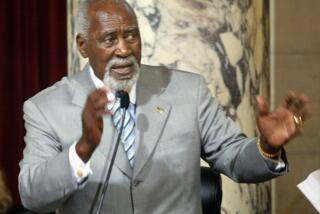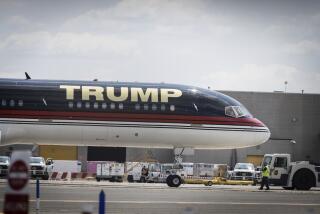Bush’s Landing on Carrier Draws Criticism
- Share via
WASHINGTON — President Bush’s dramatic arrival on an aircraft carrier off San Diego last week wasn’t necessary after all. He simply wanted to experience the thrill of a military jet’s tail-hook landing, rather than taking a more traditional helicopter ride out to the vessel, the White House acknowledged Tuesday.
About six hours after arriving aboard the Abraham Lincoln Thursday, Bush delivered a prime-time address to the nation, declaring an end to the major combat phase of the Iraq war.
Since then, his highly choreographed visit to the ship, which was returning after more than nine months of duty in the Persian Gulf region, has drawn criticism from some Democrats. They have accused the White House of staging a political event aimed at bolstering Bush’s expected reelection bid, featuring stirring images likely to end up in campaign ads.
After the president emerged from an S-3B Viking jet in a green flight suit, his helmet under one arm, he was surrounded by admiring servicemen and servicewomen -- who later turned out by the thousands to cheer him during his speech on the flight deck. The carrier was positioned during Bush’s speech so that television cameras would show an open sea in the background, rather than the California coastline.
Initially, White House Press Secretary Ari Fleischer had told reporters that Bush had to take a jet from San Diego to the Lincoln because it was “hundreds” of miles at sea, beyond a helicopter’s range.
But Fleischer set the record straight Tuesday when asked again about Bush’s unusual travel arrangements.
The spokesman’s explanation: The Lincoln, as it turned out, made faster progress than had been anticipated, due in part to good weather. As a result, the carrier was only about 30 miles offshore, and easily within helicopter range, by the time Bush arrived in San Diego.
But the president, a former pilot in the Texas Air National Guard, was set on jetting out to the Lincoln.
“The president wanted ... to see an aircraft landing the same way that the pilots saw an aircraft landing,” Fleischer said. “He wanted to see it as realistically as possible. And that’s why, once the initial decision was made to fly out on the Viking, even when a helicopter option became doable, the president decided instead he wanted to still take the Viking.”
Fleischer also dismissed questions about whether Bush’s appearance delayed the ship’s arrival, saying that it came into port exactly as scheduled.
“Keep in mind, the original day -- even before anybody thought about going to the Abraham Lincoln -- was for the [carrier] to arrive in port on May 2,” he said. “That was the date that was promised to the crews and to their families, and the date that was kept. But, indeed, the ship did make much faster progress than anticipated.”
While aboard the Lincoln, Fleischer said he asked about the Lincoln’s unexpected progress toward shore.
“It’s a factor of the weather -- they were able to get closer to shore,” Fleischer said. “But the bottom line remains the same: that the president wanted to arrive on it in a manner that would allow him to see an arrival on a carrier the same way pilots got to see an arrival on a carrier.”
Fleischer’s explanation did not satisfy all critics.
Sen. Robert C. Byrd (D-W. Va.) took to the Senate floor Tuesday to castigate the president. “I am loath to think of an aircraft carrier being used as an advertising backdrop for a presidential political slogan, and yet that is what I saw,” he said.
“I do not begrudge his salute to America’s warriors aboard the carrier Lincoln, for they have performed bravely and skillfully ... but I do question the motives of a desk-bound president who assumes the garb of a warrior for the purposes of a speech.”
Rep. Henry A. Waxman of Los Angeles, the top Democrat on the House Government Reform Committee, asked David M. Walker, comptroller general of the General Accounting Office, for a “full accounting of the costs associated with the president’s trip,” because “last week’s event -- which had clear political overtones -- was paid for by American taxpayers.”
More to Read
Get the L.A. Times Politics newsletter
Deeply reported insights into legislation, politics and policy from Sacramento, Washington and beyond. In your inbox three times per week.
You may occasionally receive promotional content from the Los Angeles Times.










